An introduction to food safety and HACCP law
- Like
- Digg
- Del
- Tumblr
- VKontakte
- Buffer
- Love This
- Odnoklassniki
- Meneame
- Blogger
- Amazon
- Yahoo Mail
- Gmail
- AOL
- Newsvine
- HackerNews
- Evernote
- MySpace
- Mail.ru
- Viadeo
- Line
- Comments
- Yummly
- SMS
- Viber
- Telegram
- Subscribe
- Skype
- Facebook Messenger
- Kakao
- LiveJournal
- Yammer
- Edgar
- Fintel
- Mix
- Instapaper
- Copy Link
Posted: 18 August 2008 | Carol Wallace, Principal Lecturer, University of Central Lancashire and Sue Powell, Co-ordinator for the North West Teaching Public Health Network | No comments yet
All businesses need to make sure that they operate within the law for a wide range of measures, including health & safety, environmental issues, weights and measures, et cetera. For food businesses, it is crucial that the food sold does not endanger public health, therefore adequate control systems must be in place. In the UK and EU, food safety requirements are clearly identified in legislation so it is important that all food businesses are aware of and keep up to date with changes in food safety laws.
All businesses need to make sure that they operate within the law for a wide range of measures, including health & safety, environmental issues, weights and measures, et cetera. For food businesses, it is crucial that the food sold does not endanger public health, therefore adequate control systems must be in place. In the UK and EU, food safety requirements are clearly identified in legislation so it is important that all food businesses are aware of and keep up to date with changes in food safety laws.
All businesses need to make sure that they operate within the law for a wide range of measures, including health & safety, environmental issues, weights and measures, et cetera. For food businesses, it is crucial that the food sold does not endanger public health, therefore adequate control systems must be in place. In the UK and EU, food safety requirements are clearly identified in legislation so it is important that all food businesses are aware of and keep up to date with changes in food safety laws.
The European Parliament (EP) is made up of 27 Member States consisting of 785 elected Members of the European Parliament (MEPs), 78 of whom are from the UK. It is based in Brussels where the MEPs, through specialist committees, meet to scrutinise proposals for new European Laws.
European Laws take three forms: Regulations, Directives and Decisions.
Regulations are directly applicable within the UK and do not have to be transferred into national laws. Regulations are either general, covering most food groups and operations, or specific, covering particular foods or businesses. For example, Regulation 854/2004 specifies hygiene rules for the control of foods of animal origin, such as shellfish. Directives describe the overall intent of the law and require each Member State to develop its own national laws to ensure compliance with the Directive. This process is known as harmonisation. Decisions are acts that concern individuals, companies or Member States. They are directly applicable in the UK.
The key food safety law applying to most food businesses operating in the UK is EC Regulation 852/2004 on the hygiene of foodstuffs. This contains requirements for both hygiene and HACCP, and is sometimes referred to as the HACCP law. Although EC Regulations are directly applicable in the UK, national legislation may be published to describe how the EC legislation will be implemented, for example The Food Hygiene (England) Regulations 2006, which covers the application of 852/2004 along with several other pieces of legislation.
Who enforces the legislation?
The Food Standards Agency is responsible for the official control of food. Enforcement functions are delegated mainly to local authorities, where environmental health practitioners (EHPs) regulate food hygiene and safety legislation and Trading Standards Officers (TSOs) regulate those relating to food standards and labelling. Both EHPs and TSOs advise upon new designs and structures of businesses as well as product safety and description.
Useful information about these food safety agencies, including enforcement agencies, and sources of guidance material on food law enforcement are described in Table 3.
Premises and facilities – meeting the hygienic design and management requirements
When setting up a food business, it is important to apply the principles of hygienic design and, as a minimum, to comply with the specific requirements laid down in Regulation 852/2004 on the hygiene of foodstuffs. This will ensure that the food business premises, services and transport are all operating to good hygienic practice and that food processes are operating safely. In addition, most food businesses need to be registered, normally with the local authority.
Annex II of the Regulation contains ‘General Hygiene Requirements for all Food Business Operators1’. Annex II is split down into 12 Chapters. Chapters 1 and 2 apply to premises and rooms in all food businesses, except for businesses operating from movable or temporary premises or private dwellings, where chapter 3 applies. Chapter 4 applies to all food transport and the remaining chapters 5-12 apply to all food operations. Table 4 on page 66 shows the key points covered in each chapter.
Control systems – HACCP and prerequisite programmes
HACCP
EC852/2004 Article 5 states that all food business operators providing food for sale must implement and maintain a food safety system based on HACCP principles (Table 5).
In addition, the legislation notes that “the HACCP requirements should take account of the principles contained in the Codex Alimentarius. They should provide sufficient flexibility to be applicable in all situations, including in small businesses.”
Essentially, all food business operators need to implement a food safety management system based on the HACCP principles and have appropriate training to do so. However, the flexibility allowed, especially for small businesses, means that a range of food safety management systems will be acceptable from the implementation of good hygiene practices for small low-risk businesses to the requirement for Codex HACCP to be applied to large food manufacturers. This has led to the development of a range of simplified food safety systems, for example Safer Food Better Business (Food Standard Agency, 2006)
Although the Codex HACCP principles (Codex, 2003) are not reproduced word for word, paragraph 2 (a-g) of article 5 (Table 5) has the same general meaning. Some commentators have noted that the legislation requires the identification of hazards, while Codex requires analysis of hazards. However, it could be argued that the only way to know which hazards must be prevented, eliminated or reduced to acceptable levels is to analyse them (Wallace, 2008).
The main differences with the HACCP requirements in the new legislation (852/2004) from previous requirements (for example, UK Food Safety (General Food Hygiene) Regulations 1995) are that the HACCP principles are named and listed (previously HACCP was not mentioned, rather hazard analysis), and that documentation and verification are now required in all businesses. The training requirements have also been increased.
Significantly, the legislation also requires the systems based on HACCP principles to be reviewed ‘when any modification is made in the product, process, or any Step’ and necessary amendments to be made to assure continuing effectiveness. (852/2004)
Prerequisite programmes
Prerequisite programmes can be defined as ‘Procedures, including GMP, that address operational conditions, providing the foundation for the HACCP System’ (NACMCF, 1997)
The internationally accepted requirements for Prerequisite Programmes (PRPs) are defined in the Codex General Principles of Food Hygiene. This document is published along with the Codex HACCP Principles and Guidelines in the ‘Codex Alimentarius Food Hygiene Basic Texts’ and is available to download online (Codex, 2003). The requirements of the EC Food Hygiene Regulation (852/2004) are closely aligned with the Codex document, as shown in Table 6 on page 69. The Regulation 852/2004 covers all prerequisite programme areas mentioned in Codex, with the exception of the product information and consumer awareness section. The requirements of this section are covered separately in other legislation on labelling and traceability.
Designing safe products
The HACCP and prerequisite programme requirements described above will control the safety of food processes and operations, but it is still necessary to ensure that individual product recipes are safe. This is particularly relevant at the new product development stage, where novel ingredients may need special considerations. The key to product safety is hazard analysis of new materials and product formulation/design, with the development of appropriate control measures.
Allergen considerations and labelling
Allergen control is an emerging area of concern and detailed labelling requirements are now in place in the EU (see Table 6 for legislation references). Along with cooking and storage instructions, allergen labelling is a critical food safety information requirement for the consumer.
Meeting the food safety legal requirements
A company that uses the principles of hygienic design and good manufacturing practice, and operates HACCP systems to assure the safety of its products and processes will meet its legal obligations for food safety. Although the legislation may at first seem daunting, there are useful pointers on the issues that need to be considered and additional guidance material (e.g. Codex, 2003) will help to clarify the requirements. Flexibility of approach means that any type of food business should be able to implement a food safety system that meets its needs.
Want to know more about food safety law?
University Certificate in International Food Law available at UCLAN – part of the eLearning MSc in Food Safety Management. See http://www.uclan.ac.uk/online/foodsafety/index.htm for details.
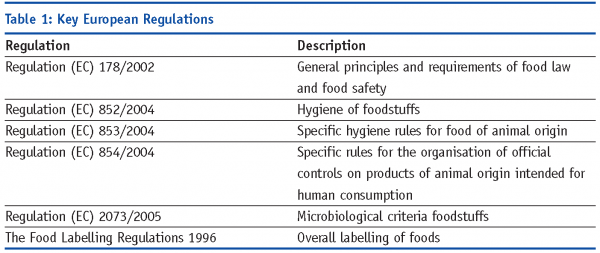



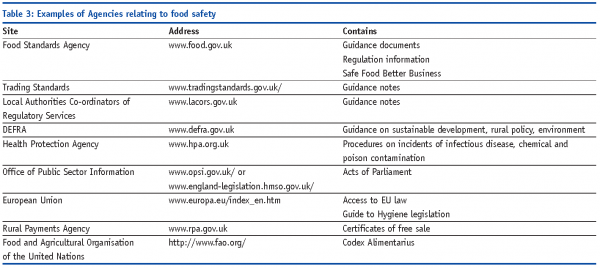

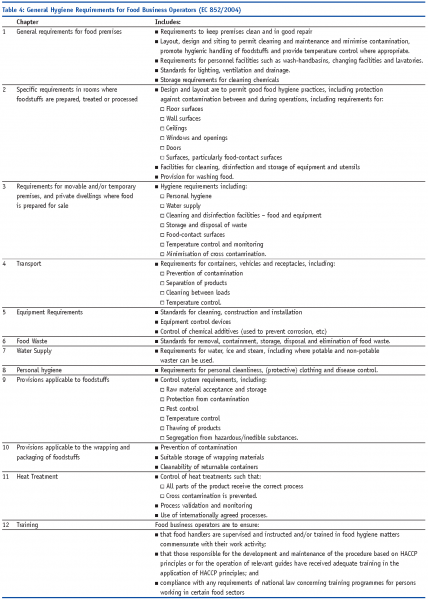

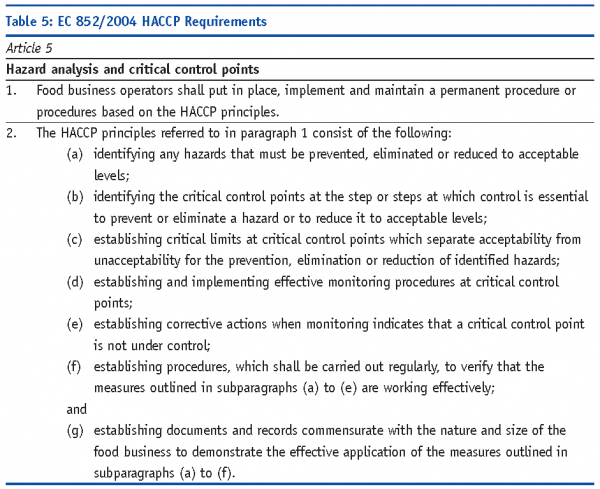

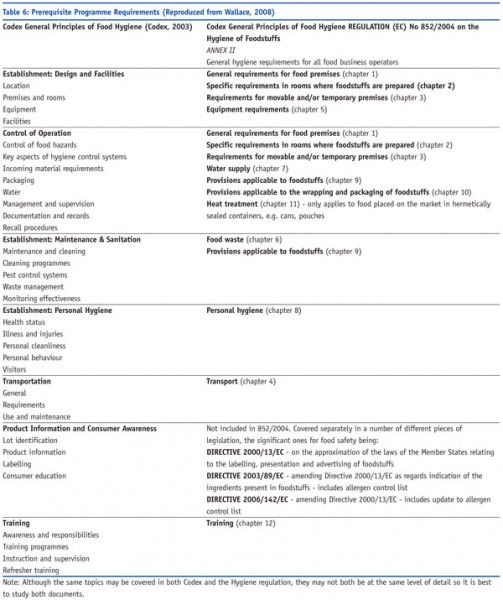
References
- With the exception of primary production businesses, which are covered by annex I
Codex Alimentarius, 2003, Food Hygiene Basic Texts, 3rd Edition, http://www.fao.org/docrep/006/y5307e/y5307e00.htm
Food Standards Agency, 2006, Safer Food Better Business, http://www.food.gov.uk/multimedia/pdfs/sfbbfullpack.pdf
Wallace, 2008, Intermediate HACCP, 2nd Ed, Highfield Publications (www.highfield.co.uk









